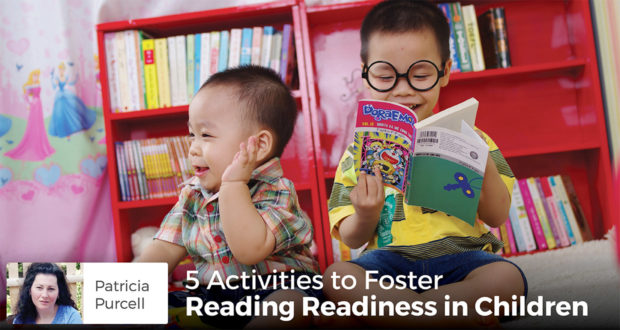Summary
Patricia Purcell discovers that early literacy activities not only prepares kids to be good students but that the simplest projects can be the most special!One of the greatest challenges homeschooling parents face each day can be juggling multiple ages of children.
This is particularly true for those who have one or more students who are getting into harder, more time consuming work and also have younger children that need attention.
As tempting as it may be just to park your preschooler in front of the TV to watch educational programming, the early years are an important time for getting your child prepared to be a good student in the future. When we first started homeschooling, I experienced this juggling problem myself.
Though my toddler was content to play quietly with puzzles or blocks while I taught long division to my third grader, my four year old needed something more.
My solution was to come up with some fun learning activities for my preschooler to keep her engaged and occupied and also get her ready to learn.
When I told my children that I was writing this article, each one of them eagerly reminded me of early literacy activities that I had done with them, proving that sometimes the simplest moments are the ones that make kids feel special!
Here are some of their favorites.
1. Learning Station
Keep art supplies, quiet games, and simple workbooks in a designated spot for your child.
If you have a small desk or table just for his use, place it near your own work area so that it’s easy for you to assist when needed. He’ll take his work more seriously if it’s treated with the same importance as that of his older siblings.
2. Alphabet Book
Naturally every homeschooling family owns at least one alphabet book, but making a homemade one takes your child’s learning to a whole new level. It’s cheap, it’s simple, and chances are you already have the supplies on hand.
Materials needed: colored construction paper, glue sticks, hole punch, yarn, safety scissors, old magazines
- Each day label one sheet of construction paper with a letter of the alphabet, i.e. A, a.
- Review the sound(s) of the letter with your child and talk about some words that begin with that letter (apple, aardvark, ape, etc.).
- Help your child get started by looking through some old magazines together to locate pictures of items that begin with that letter. Allow him to cut them out with the safety scissors.
If a family member’s name happens to begin with that letter, supply your child with a photo of that person to use.
- Have him glue the pictures into his ‘book’.
- When you reach the end of the alphabet, use the hole punch and yarn to fasten the pages together into a book.
3. Letter People
For this activity, you again need construction paper, old magazines, and glue sticks…and just a dash of artistic talent.
- Cut out very large bubble letters for your child. Add whimsical eyes, arms, and legs to give it the appearance of a person.
- Name each letter and give it a personality, i.e. Mr. D. likes dancing, donuts, and dogs.
- Then help your child locate or draw pictures related to the letter person and glue them onto it.
- You might want to mount each letter person onto cardstock or hang them on the wall in the schoolroom.
4. Letter Days
It’s easy to coordinate these with the activities above, if desired, or just do them on their own. Declare a letter of the day at your house.
Read books and do activities to go along with that letter. For example, if your letter of the day is C, you could:
- Read C is For Clown, by Stan and Jan Berenstain
- Play a clapping game
- Light a candle (or a battery operated one)
- Bake letter-shaped cookies
- Sing the Cookie Monster song, “C is for Cookie”
5. Word Hunt
This activity is great for older preschoolers who are ready to start learning some basic words. Materials required: sticky notes, pen.
This requires just a little prep time, but it has the potential to keep your youngster busy for awhile.
Even better, it can be repeated endlessly. What kid doesn’t love a treasure hunt?
- Write down on the sticky notes at least twenty simple words for objects around your house, and attach them to the related objects. (It’s best to do this while your child is still sleeping so there’s no danger of peeking.) You might want to also jot down a quick list for yourself of the words and where you placed them, so that you can offer hints as needed.
- To begin the search, point your child toward the first note (maybe on his bed or mug), and tell him how many are hidden throughout the house. You might want to label some toys along the way (i.e. bear, blocks) in hopes of distracting him a bit longer.
- Take advantage of the peaceful interlude to work with your older children.
- When he finds them all, review the words with him again to see how many he remembers.
Fostering Reading Readiness
Of course there are still other ways to foster reading readiness that don’t require any advance planning. In order to raise a child who is eager to read, you must read with him frequently.
Keep books in your home, and visit the library regularly. Make reading together a familiar part of your school day that your children will all look forward to. Even the littlest children will benefit from hearing great stories read aloud.
The years of early childhood are precious and fleeting.
Take advantage of these years and do some activities that teach your little one that learning is fun. He’ll get ready for the challenges of the school years, and you’ll both have warm memories of your special time together.
Do you have any favorite ways to get your young children ready to read?

 Seton Magazine Catholic Homeschool Articles, Advice & Resources
Seton Magazine Catholic Homeschool Articles, Advice & Resources

